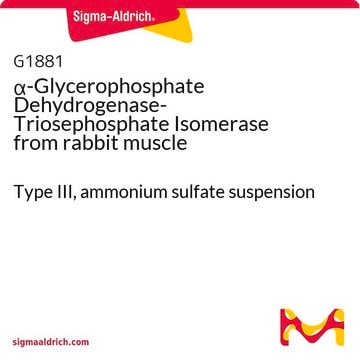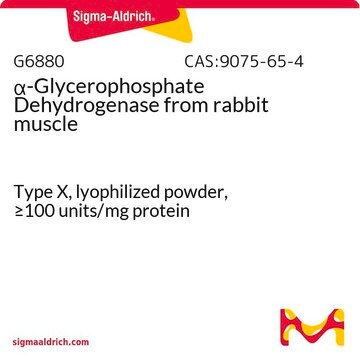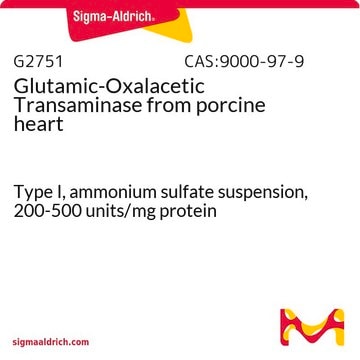G6751
α-Glycerophosphate Dehydrogenase from rabbit muscle
Type I, ammonium sulfate suspension, 100-300 units/mg protein
Sinónimos:
sn-Glycerol-3-phosphate Dehydrogenase from rabbit muscle, sn-Glycerol-3-phosphate:NAD+ 2-oxidoreductase
About This Item
Productos recomendados
biological source
rabbit muscle
type
Type I
form
ammonium sulfate suspension
specific activity
100-300 units/mg protein
storage condition
(Tightly closed)
technique(s)
activity assay: suitable
color
white
foreign activity
Lactic dehydrogenase, pyruvate kinase, aldolase, and glyceraldehyde-3-phosphate dehydrogenase ≤0.01%
Triosephosphate isomerase ≤0.02%
storage temp.
2-8°C
¿Está buscando productos similares? Visita Guía de comparación de productos
Categorías relacionadas
General description
Research area: Cell Signaling
Application
- in the reaction mixture to measure the glycerol kinase activity
- to demonstrate compartmentalized enzymatic reactions where NADH is involved
- in the reaction mixture assay for L-fuculose-1-phosphate aldolase
Biochem/physiol Actions
Unit Definition
Physical form
Preparation Note
Analysis Note
related product
signalword
Danger
hcodes
pcodes
Hazard Classifications
Resp. Sens. 1
Storage Class
12 - Non Combustible Liquids
wgk_germany
WGK 1
flash_point_f
Not applicable
flash_point_c
Not applicable
Certificados de análisis (COA)
Busque Certificados de análisis (COA) introduciendo el número de lote del producto. Los números de lote se encuentran en la etiqueta del producto después de las palabras «Lot» o «Batch»
¿Ya tiene este producto?
Encuentre la documentación para los productos que ha comprado recientemente en la Biblioteca de documentos.
Los clientes también vieron
Artículos
Instructions for working with enzymes supplied as ammonium sulfate suspensions
Nuestro equipo de científicos tiene experiencia en todas las áreas de investigación: Ciencias de la vida, Ciencia de los materiales, Síntesis química, Cromatografía, Analítica y muchas otras.
Póngase en contacto con el Servicio técnico
















